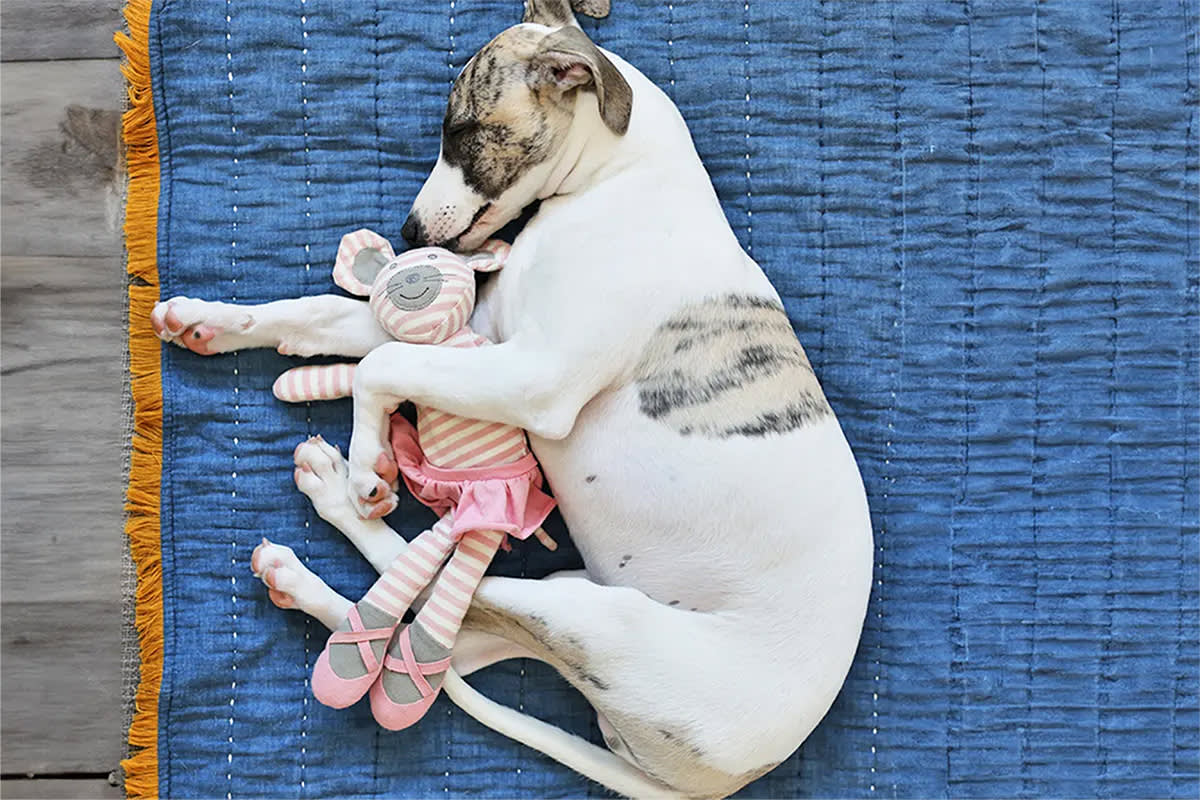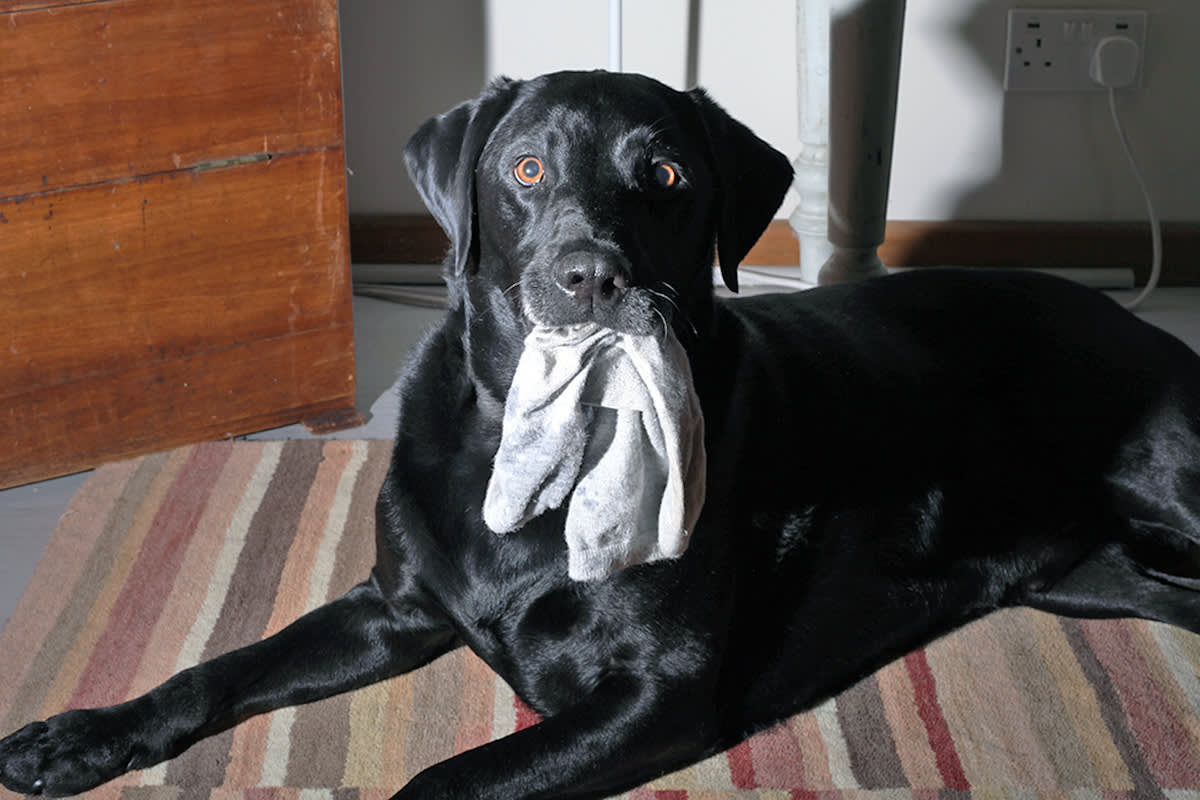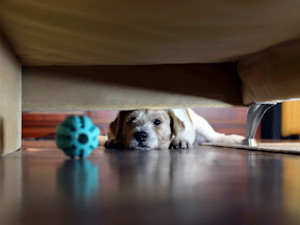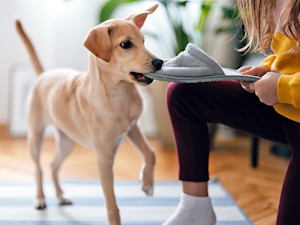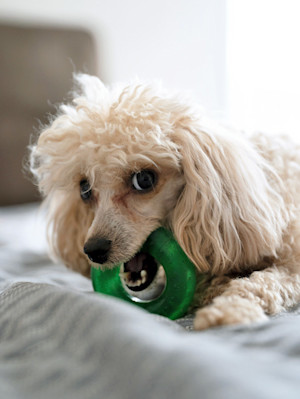
Share Article
Forget your emotional-support water bottle — check out Cheddar the cat’s emotional-support pink bikini topopens in new tab that he drags around his pet parent’s house with his teeth. Seriously, I’m not kidding. The internet is rarely as fun as it used to be, so when the algorithm fed me this video a few weeks ago, I was absolutely delighted. I watched it multiple times and thought, We really don’t deserve animals. Also, the comments section is amazing if you need a pick-me-up.
Jokes aside, this got me thinking about emotional-support items. I remembered watching a viral videoopens in new tab a few years ago about how Labrador Retriever Ollie got attached to a pumpkin and carried it around. And I’ve seen countless videos about dogs and their emotional-support blankiesopens in new tab.
It seems to be a thing for us, too. These days, we humans name anything from a keychain to a weighted blanket as a comfort object — and of course, we know that babies and kids can have them in the form of lovies, blankies, and special teddy bears. But can animals really have emotional-support items like we do? I asked two pet behavior experts what we should think of this phenomenon.
Do dogs and cats attach to random comfort objects?
The short answer is: yes. Like human children and other animals in the animal kingdom that are collectors (i.e. magpies, squirrels, some species of monkeys, and hermit crabs), dogs and cats can develop attachments to specific things.

“Dogs develop these attachments very similarly to how children do!” says Hannah Richteropens in new tab, New York City-based dog trainer. “This happens because items can provide comfort and security which can help to reduce stress and anxiety.”
Dogs and cats might do more than just carry their emotional-support object around the house. They might interact with it, too. “We see dogs and cats use these items for self-soothing behaviors, whether snuggling with them, licking, kneading, or nibbling at them,” certified behavior consultant Cathy Madsonopens in new tab says. “These items might smell like their person or offer predictable comfort.”
That reminded me of when I lived with my roommate’s cat, Pepper. Often, when I came home from a run, I’d put my sweaty, disgusting clothes on the wood floor next to my laundry basket so they got an opportunity to dry a bit before throwing them into the bin. While I was showering, Pepper, the wild calico kitty, would take that opportunity to lie on top of them. To this day, when I visit her or cat sit, she’ll lie on anything I bring into her house, like a jacket or a purse (likely because my workout clothes are no longer available to her).
“Often, these items are things used or worn by the person the dog has the most attachment to such as shoes, socks, or underwear,” Richter says.
Although this makes sense to some extent, it’s still gross, Pepper. Your pet’s choice of emotional-support item may not make sense to you, but hey, it’s their life.
How do dogs and cats pick emotional-support objects?
We’re asking the question that everyone wants to know the answer to: How did Cheddar decide on a bikini?
“Comfort is based on emotional associations, not necessarily logic,” Madson says. “If a sock, slipper, or random toy helped them feel safe once, they may stick to it. Puppies might have a close attachment to a certain toy that they snuggled with when they first came to their new home and still find it comforting.”
That level of emotional attachment makes sense. For my Cavalier King Charles Spaniel Ellie’s entire decade on earth, she insisted on playing with and protecting a disemboweled yellow crab toy, which was essentially a yellow fabric wrapped around a squeaker (aka garbage). It was probably 15 to 20 years old and had originally belonged to my first dog, Chloe. My theory is that she loved it so much because she missed Chloe after she died.
What do you do if your pet has chosen something… a little unconventional?
Like what if they are in love with something that could decompose or is unsafe? A pumpkin, perhaps. Or a literal piece of trash, like a leftover string-cheese wrapper upon which your dog seems to have imprinted. Madsen says if the item isn’t putting your pet at risk for physical harm, just keep an eye on them with it.
“If they have one that they’ve picked out themselves, it’s OK to let them keep it as long as it’s safe and appropriate,” Madson says. “Monitor the item to see if it needs to be washed or cleaned. If you are cleaning it, give your pet an alternative self-soothing activity, such as a licking mat or chew.”
When is an emotional-support item unhealthy?
Unhealthy is a relative word, but a special item might be mentally unhealthy for a pet if they become possessive of it. Snarling, growling, and even biting means that they’re starting to resource guard it. Pet parents should start limiting access to the emotional-support item and teach your pet to “drop it” and accept treats in return.
On the other side of the coin, if pets are stressed, they might begin to chew or ingest their emotional-support item, which pet parents should take as a sign of distress. If that happens, you should consult a cat or dog behaviorist to get at the root of the issue.
What should you do when the emotional-support item gets lost or is on its last legs?
So, let’s say that your dog has bonded with an emotional-support gourd; you will obviously need to eventually throw it away. Or maybe it just disappeared without a trace, like the elusive Busy Bee toy in the movie Best in Show. This opens up a different can of worms for pet parents. To some extent, it depends on your pup and their level of attachment to the item.
“If your pet doesn’t seem distressed without the item, then there is no need to replace it,” Madson says. “They may choose a different item in the future. If you need to replace it, use something with similar texture, smell, or shape. If you can, introduce the new one gradually alongside the old one to ease the transition. If you can’t slowly introduce it, make it more enticing by playing with your pet with it or placing it in your pet’s bed to help with scent transfer.”

Alicia Kort
Alicia Kort is a writer and editor living in Brooklyn. Her work has appeared in Esquire, InStyle, Apartment Therapy, The Kitchn, Parade Home & Garden, Newsweek, Interview, Brooklyn magazine, and more. In her free time, she runs, reads, and spends time with her dog-nieces, Maya and Lady, and her cat-niece, Pepper. In her work, she focuses on pet behavior, pet-friendly spaces, and the lifestyle commerce space.
Related articles
Why Do Dogs Destroy Some Toys and Not Others?
And it always seems to be the ones we painstakingly pick out for them.
![a small dog stares at a ball under the couch]()
Why Is My Dog Obsessed With Shoving Things Under the Couch?
Thankfully, I found an easy fix.
![Sad black dog staring outside a window at home.]()
How to Ease Your Puppy’s Separation Anxiety
It’s not easy for either of you—but this can help.
![Cute dog trying to get someone's attention.]()
9 Signs Your Dog Wants Your Attention Right Now
They need some cuddles, stat.
![Puppy stealing slipper from woman at home.]()
How to Teach a Dog to “Drop It”
The most important cue your dog doesn’t know. Yet.
![Small white poodle guarding its toy at home.]()
What to Do About Toy-Aggression in Dogs
Sometimes, when your sweet pup gets obsessed with their toys, it can be more than enthusiasm.
